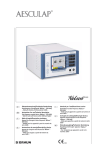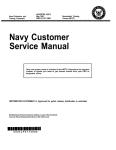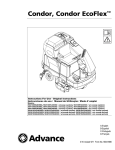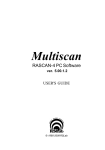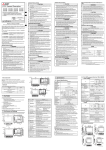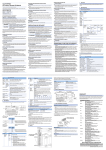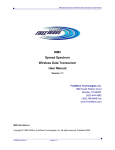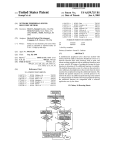Download Апарат за електрохирургия
Transcript
USER MANUAL Electrosurgical unit 150W KENTAMED 1FE 150W digital mono/bipolar Abbreviations EMC - Electromagnetic Compatibility ESD - Electrostatic Discharge HAC - Hospital Antiseptic Concentrate NE - Neutral electrode HF - High Frequency Symbols providing data for the device (equipment) Manufacturer identification Product data (lot/batch or fabrication/serial no., date of manufacture, etc.) Date about the lot (lot number and/or serial number, production date etc.) Temperature limits the product is intended to work within Symbols laid on the device (equipment) • Symbols and notices, relating the safety Refer to the manual. Applied part type BF (not applicable for direct use for heart operations) Symbol applied for a HF-isolated patient circuit. Indicators for statuses, when the output power is switched-off automatically: o OH - Over Heating; o NE - Neutral Electrode contact failure; o PF - Output power failure. • Symbols and inscriptions used for identification of controls and operating mode selectors. All controls marked with yellow colour designate the operating mode “Cutting, while those marked with blue colour – the operating mode “Coagulation. The symbols on operating mode selection push-buttons and switches are: Operating mode Pure CUT (smooth cutting); Operating mode Blend CUT (Cutting with increased degree of haemostasis); Operating mode Contact COAG (standard monopolar coagulation); Operating mode SPRAY COAG (superficial sparking coagulation); Operating mode BICOAG (Bipolar coagulation) Operating sub-mode Micro BICOAG (micro-bipolar coagulation) Neutral electrode Finger-switch handle for monopolar electrodes Bipolar forceps Symbols in the Manual «Caution!» or «Important information!» CONTENTS 0) SAFETY 0.1. OBJECTIVES 0.2. SAFETY INSTRUCTIONS 0.2.1.1. GENERAL 0.2.1.2. ELECTRICAL SAFETY 0.2.1.3. PREVENTION OF EXPLOSION 0.2.1.4. ELECTROMAGNETIC COMPATIBILITY 0.2.1.5. HIGH FREQUENCY ELECTRO-SURGERY 0.3. RESPONSIBILITY 0.4. CONTRAINDICATIONS TO ELECTRO-SURGERY APPLICATION 1) Introduction 1.1. Purpose and scope of application 1.2. Functions 1.3. Technical characteristics 2) Equipment description 2.1. Main equipment components 2.2. Command push buttons, indicators and accessory connectors 2.3. Tools and accessories 3) Way of operation 3.1. Installation 3.2. Accessories’ connection to equipment 3.3. Switching equipment On/Off 3.4. Selection and adjustment of operating modes 3.5. Activation of output power 3.6. Neutral electrode (plate) positioning 3.7. Output power adjustment 3.8. Audible signal volume adjustment 3.9. Cleaning of equipment and accessories 3.10. Sterilization 4) Inspection and maintenance 4.1. Inspection 4.1.1. Scope of inspections 4.1.1.1. Visual inspection 4.1.1.2. Functional inspection 4.1.1.3. Technical inspection for safety requirements implementation 4.1.2. Checks outcome 4.2. Maintenance 5) Faults, service and guarantee 5.1. 5.2. 5.3. 5.4. Faults Maintenance Guarantee Period of exploitation 6) Technical information 6.1. 6.2. 6.3. 6.4. General Conditions of environment Transportation and prolonged storage Standard accessories 7) Appendices 7.1. Check on adherence to safety requirements 7.1.1. Test 1 : General status 7.1.2. Test 2 : Functional status 7.1.3. Test 3 : Check for electrical safety 8) 7.2. Product disposal References 0. SAFETY 0.1. OBJECTIVES The equipment is suitable for short-time use with a prolonged idle period. 0.2. SAFETY INSTRUCTIONS 0.2.1. GENERAL • The equipment may be used solely by qualified personnel trained to apply HF electro-surgery; • Only authorized individuals may open and/or repair the device/ equipment; • Obey instructions and guidelines given in this user manual; • Always put the equipment on a steady horizontal surface; • Never put things on the equipment; • Equipment operation in an opened/ disjointed state is forbidden; • Do not expose the equipment under direct sunlight or place it in vicinity of heat radiating sources; • Do not sterilize the equipment. Clean and disinfect the equipment according to the instructions (see clause 5 INSPECTION AND MAINTENANCE); • In order to use the equipment in an optimal way, a competent surgeon’s estimation on the possibility to apply the suggested electro-surgery. Depending on the examination outcome, a plan for surgical intervention on the patient must be prepared. This has to lower to a minimum the contingent risks related to equipment use; • Always keep the operating instructions somewhere nearby to equipment application location, in order to be able to make any reference whenever necessary. 0.2.2. ELECTRICAL SAFETY • Connect the equipment only to a power supply in good order and complying to applicable safety requirements in the medical field as determined on local level (by the relevant national legislation); • For equipment electrical connection use only electrical outlets conforming to requirement of applicable normative documents; 0.2.3. PREVENTION OF EXPLOSION • Never use the equipment at locations where inflammable gases or vapours exist. In case of contingency keep in mind the listed below warnings; • Switch off the equipment when not in immediate use. 0.2.4. ELECTROMAGNETIC COMPATIBILITY • Taken as a whole, electrosurgical equipment generates disturbances just because of its nature. It is possible to disturb the normal operation of other near placed equipment (pacemakers, ECG monitors, blood pressure monitors and other devices for monitoring, infusion pumps etc.) • Medical electrical equipment require special precautions on electromagnetic compatibility (EMC). Follow the device installation guidance (see clause 3.1 INSTALLATION); • Use solely the equipment accompanying accessories or those prescribed for joint application. Other types of accessories might exercise adverse impact on patient or some nearby working equipment. 0.2.5. HIGH FREQUENCY ELECTROSURGERY When selecting the possible application of HF electrosurgical equipment (surgical accessories inclusive), with an eye to avoid incompatibility and unsafe operation, the following should be considered: - operator has to avoid HF output settings where the maximum output voltage could exceed the rated voltage of accessories (applied parts) used; - in selection of a monitoring neutral electrode the presence of a contact quality monitor has to be accounted for. In HF surgical equipment application, with a view to diminish the risk of occasional burns, the following precautions are needed: - The whole area of neutral electrode must be assuredly fit tight to the patient body and as closely as possible to operational field; - Patient must not come into contact with metal parts what either are not earthed or have a significant capacity against earth (e.g. operational table supports, etc.). Use of isolated covers is recommended for the purpose. - Any skin-to-skin contact (e.g. between patient’s hands and body) must be avoided. Avoidance may be effected by insertion of a dry gauze; When HF surgical equipment is used simultaneously with physiological monitoring equipment on the same patient, any monitoring electrodes should be placed as far away as possible from surgical electrodes. Use of needle-shaped monitoring electrodes is discouraged. In all cases, monitoring systems incorporating HF current delimiting devices are recommended. Cables used for connection of the surgical electrodes must be positioned in such a way that contact with the patient or other leads is avoided. Active electrodes, temporarily out-of-use, should be kept in a location surely isolated from the patient; For surgical procedures, where HF current could flow through body parts having a relatively small cross-sectional area, use of bipolar techniques may be preferred in order to avoid undesirable tissue damage. The output power selected should be as low as possible for the intended goal. Some devices or accessories can be a source of hazard at low power levels. For instance, with argon beam coagulation the risk for gas embolism rises if there is insufficient HF power to produce a rapid, impermeable layer over the tissue treated; Apparently low output or failure of the HF surgical equipment to perform correctly at normal operational settings might be caused by faulty application of the neutral electrode or poor contact in its connections. In this case, the fitting of both neutral electrode and its connections should be checked before attempting to apply a higher output power. The use of inflammable anaesthetics or oxidizing gases, such as nitrous oxide and oxygen, should be avoided if a surgical procedure is carried out in the region of the thorax or the head, unless these agents are compulsorily sucked away. Whenever possible, non-flammable agents should be used for cleaning and disinfection. Flammable agents used for cleaning or disinfecting, or as solvents of adhesives, should be allowed to fully evaporate before application of HF surgery. There is a risk of pooling of flammable solutions under the patient or in body depressions such as the umbilicus, and in body cavities. Any fluid spilled over and pooled in these areas should be mopped up before the HF surgical equipment is used. Some materials, for example cotton, wool and gauze, when saturated with oxygen, may be ignited by sparks generated in normal use of HF surgical equipment. A possible hazard exists for patients with cardiac pacemakers or other active implants, because either interference with the pacemaker action may occur, or the pacemaker may be damaged. In case of doubt, approved qualified advice should be obtained. Disturbances created through the HF surgical equipment operation may influence adversely the performance of other electronic equipment. The operator should inspect regularly: - the accessories, in particular electrode cables and endoscopically used accessories, should be checked for possible damage; - associated equipment and active accessories, including separately supplied parts thereof, for their rated voltage. For HF surgical equipment, the maximum output voltage for each HF surgical mode and instruction regarding the rated accessory voltage as follows: - For situations where the maximum output voltage ( Umax) is less than or equal to 1 600 V, then provide instruction that only such associated equipment and active accessories should be selected that have a rated accessory voltage equal to or greater than the maximum output voltage; - For situations where the maximum output voltage ( Umax) is greater than 1 600 V, calculate the variable y using the formula: Take the smaller value of variable y and the number 6. If the result is less than or equal to the crest factor for that HF surgical mode, then associated equipment and active accessories should be selected that have a rated accessory voltage equal to or greater than the maximum output voltage. - For situations where the maximum output voltage ( Umax) is greater than 1 600 V, and the crest factor is less than the variable y calculated above, a warning shall be provided that any associated equipment and active accessories used with such mode or setting must be rated to withstand the combination of actual voltage and crest factor. - Where the maximum output voltage varies with the output setting, that information shall be presented diagrammatically as a function of output setting. Attention! Failure of the HF surgical equipment could result in unintended increase of output power. For this reason the operating staff has to provide for its annual checking. To assure safety and reliability at work, only defined in this manual compatible monitoring neutral electrodes are to be used. If other than a compatible monitoring neutral electrode is used and the safe contact between neutral electrode and patient is lost, the equipment will not energize the due audible alarm. 0.3. RESPONSIBILITY Manufacturer will not be kept liable for operator, patient or third person injures, nor for equipment damage, in case of: • incorrect diagnosis of the individual subjected to surgical operation; • improper use of the equipment or the applied parts; • erroneous interpretation of or disregard to the user instructions; • poor servicing and/or maintenance of the equipment; • maintenance or repair done by unauthorized for the purpose individuals. Neither manufacturer nor relevant dealer can be kept liable, in any way of any character, for transfer of infections by means of the accessories. 0.4. CONTRAINDICATIONS TO ELECTROSURGERY APPLICATION Use of HF surgery is contraindicated or hazardous in the following cases: • patients with cardiac pacemakers or other active implants; • work in parallel with life-preserving apparatus not able to function in presence of high frequency radiation; • operation in environment where easily inflammable gases/ vapours and materials are present. 1. Introduction 1.1. Destination and fields of application APPLICATION: DESTINATION: 1.2. Minor and medium surgery Ideal for medical, dental and veterinary offices and clinics Functions Electrosurgical unit 150W is an intelligent, microprocessor controlled electrosurgical unit. It characterizes with functional completeness, reliable operation, operating comfort and increased patient’s safety. The unit has 150W maximal output power and 5+1 operating modes, allowing the surgeon to obtain a large spectrum of different tissue effects. The operating modes are separated in two groups (fields): • Group I - the group of cutting modes (Yellow field), which includes: o Pure CUT - smooth cutting, o Blended CUT - cutting with increased degree of coagulation, • Group II - the group of coagulating modes (Blue field), which includes: o Contact COAG - a standard coagulation, o SPRAY COAG – non-contact, sparking coagulation with superficial effect, o Bipolar COAG - bipolar and Micro bipolar coagulation Each of these modes has independent power setting, shown by digital LED indications – one 3digits indicator per each group. A digital memory stores the last power settings. The unit can be activated by two-button finger-switched handle or by twin footswitch. Overheating (OH) and Power failure (PF) sensors as well as Neutral Electrode Monitoring System (NEMSY) increase the patient’s safety. A status monitor on the front panel indicates if some of the controlled parameters are out of the norm. If this happen, the control circuit immediately switches off the output power and generates a sound alarm. 1.3. Technical characteristics Electrosurgical unit 150W Pure CUT Blended CUT Contact COAG SPRAY COAG Bipolar COAG Working frequency [KHz] Modulation frequency [KHz] Patient safety Activation Dimensions (W x D x H) in mm Weight [kg] - Technical characteristics Maximal Output Power Macro mode micro mode 150W / 500 Ohms 130W / 500 Ohms 100W / 300 Ohms 20W / 5000 Ohms 100W / 100 Ohms 35W / 100 Ohms Crest Factor 460 33 NEMSY (Neutral Electrode Safety System) Twin footswitch and Hand Switched Pencyl 255 x 215 x 85 5 1.6 2.1 3.0 7.0 1.5 2. Description of the unit 2.1. Basic components of the unit The basic components of the Electrosurgical unit 150W are a power supply module, a power generator and a control module. The unit is built in a plastic housing with a front panel and a rear panel and conveniently placed on it controls, indications and connectors for the accessories. 2.2. Controls, indications and connectors FRONT PANEL OF THE UNIT 1. Socket for the Neutral Electrode’s cable. 2. Push-button for increasing the power setting for Pure and Blended CUT modes 3. Push-button for decreasing the power setting for Pure and Blended CUT modes 4. Sockets for active electrodes handles – as for Hand-switched as well as for foot-switched handles (pencils) 5. Push-button for increasing the power setting for Contact, SPRAY and Bipolar COAG modes 6. Push-button for decreasing the power setting for Contact, SPRAY and Bipolar COAG modes 7. Sockets for the bipolar accessories 8. Red LED indicating an Over Heating (OH) of a power module of the unit. If this happen the output power is immediately switching down and a sound alarm is generated. The normal work can continue after several minutes, when the power module of the unit comes to normal operating temperature. 9. Red LED indicating a Neutral Electrode contact failure (NE). If this happen the output power is immediately switching down and a sound alarm is generated. This indication is generated by NEMSY in some of the next situation: a. When a bipolar (split) neutral electrode is used and it’s contact with the patient’s body is not sufficient b. When the connector of the neutral electrode’s cable (in cases of bipolar or monopolar NE) is damaged or not coupled to the socket 1 10. Red LED indicating a Power Failure (PF) in a situation when the output power exceeds the desired power setting. If this happen the output power is immediately switching down and a sound alarm is generated. 11. Push-button, selecting the Blended CUT mode – cutting with more haemostasis 12. Push-button, selecting the Pure CUT mode – a smooth cutting, similar to classic scalpel 13. Yellow LED indicating the activation of output power at pre-selected cutting operating mode 14. Digital display indicating the output power setting corresponding to pre-selected cutting operating mode 15. Push-button, selecting the Contact COAG – a standard monopolar coagulation 16. Push-button, selecting the SPRAY COAG – a superficial monopolar coagulation 17. Blue LED indicating the activation of output power at pre-selected coagulating operating mode 18. Digital display indicating the output power setting corresponding to pre-selected coagulating operating mode 19. Push-button, selecting the Micro BICOAG operating mode with possible power settings between 1 and 35W 20. Push-button, selecting the BICOAG operating mode with possible power settings between 1 and 80W REAR PANEL OF THE UNIT 21. Power ON/OFF switch ( I = ON, 0 = OFF ) 22. Socket for safety fuse 2.5А / 220V 23. Potentiometer for acoustic signal volume adjustment. 24. Socket for the mains power cable 25. Socket for two-sections footswitch coupling 2.3. Instruments and accessories The most used accessories are: • Mains power cable • Twin footswitch with yellow and blue sections respectively for cutting and coagulation • Finger-switched handpiece for active monopolar electrodes • A set of different monopolar electrodes for cutting and coagulation. Α Neutral Electrode with a cable for it. The unit can work with a simple plate neutral electrode as well as with a split plate neutral electrode. The use of split neutral electrode provides maximal safety for the patient thanks of the Neutral Electrode Monitoring System (NEMSY). • Bipolar forceps with an European coupling • Other bipolar electrodes / with an European coupling / • Silicon bipolar cable with a socket for bipolar forceps and bipolar electrodes. The other side of this cable ends with two “banana jacks for coupling to the ESU (sockets 7 of the front panel). 3. Method of operation 3.1. • Installation The unit is placed on a specially selected place in the Operating Room (OR) so it can be accessible to the people, who are responsible for setting the working modes and the necessary output power during the operation. In the same time the distance to the • • • operating field must provide the surgeon and his assistants enough operating space, having in mind that the patient cables are with 3 meters length typically. The foot switch must be placed on the flour in the suitable for the surgeon place. The electrical installation of the OR must be in perfect condition. To avoid the electromagnetic interference with other equipment, working in the same room, it is recommendable to place the electrosurgical unit and his cables as far as possible from it. 3.2. • • • • • Connecting of the accessories to the unit Check if the power switch 21 is in position “0 – off. Connect consecutively the mains power cable to the socket 24 of the rear panel and to the mains power socket on the wall of OR. Connect the cable of the footswitch to the socket 25 on rear panel. Connect the 6mm jack connector of the neutral electrode cable to the socket 1 on the front panel. This connector is identical for the cables of both mono-polar and bipolar (split) neutral electrodes. Connect the three-banana connector (type Valleylab) of the finger-switch electrode handle to the socket 4 on the front panel. If you use a foot-switch electrode handle, connect the banana to the right socket of the group sockets 4. Connect the bananas of the bipolar silicone cable to the sockets 7 on the front panel. 3.3. Switching ON/OFF the unit The unit can be switched-on by turning the power switch 21 in position “І. All LED indicators on the front panel, including all segments of the digital indicators 14 and 18 must go on for a second. This is an initial LED-test, allowing the operator to see if all indicators are working properly. After the initial test is finishing, all indicators must go out, except some indicators: • In the “yellow field for cutting modes: o The LED on the push-button (11 or 12), corresponding to the pre-selected operating mode o The digital indicator in the yellow window, showing the power setting for the preselected operating mode. • In the “blue field for coagulating modes: o The LED on the push-button (15, 16, 19 and/or 20), corresponding to the preselected operating mode. Note that when the Micro bipolar mode is pre-selected, two LED’s are switched – on the buttons 19 and 20. o The digital indicator in the blue window, showing the power setting for the preselected operating mode. You can switch-off the unit by turning the power switch 13 in position “0. 3.4. • • Setting the operation mode You can select the desired operating mode by pushing the corresponding push-button, after which the corresponding button-indicator is switching on. For each of the group modes, described in 1.2. the surgeon selects the desired working mode. So he must push one of the buttons 11 and 12 for cutting (group І) and one of the buttons 15, 16, 19 and 20 for coagulation (group ІI). • • Preliminary selected is that working mode, whose button-indicator is switched on. It is not possible to select two or more working modes of the same group simultaneously (an exception is the Micro BICOAG mode, which is a sub-mode of BICOAG) 3.5. Activation of the output Only one of the preliminary selected working modes can be activated in a single moment. Pushing a button of the finger-switch handle or pressing some section of the twin footswitch can make the activation. • The yellow button of the finger-switch handle or the yellow section of the twin footswitch activates the preliminary selected working mode of a group І (one of the cutting modes). A corresponding sound and the indicator 13 are switched on till the button (footswitch) is pressed. • The blue section of the foot-switch can activate any of the preliminary selected coagulating modes of a group ІІ. The blue button of the finger-switched pencil activates only the preliminary selected monopolar coagulating modes. A corresponding sound and the indicator 17 are switched on till the button (footswitch) is pressed. The preliminary selected working mode can be activated and the pre-settled output power can be delivered to the patient’s tissue pressing the footswitch or finger-switch (button on the electrode handle). Switching on the corresponding LED indicator (13 or 17) as well as corresponding sound (different for every operating mode) accompanies the activation of the output power. The output power will be activated as long as the footswitch or finger-switch (button) will be pushed. If Over Heating, NE Connection Failure or Power Failure is occurred during the activation of output, the output power is automatically switched off; the corresponding LED indicator (OH, NE or PF) and a sound alarm are switched on as is described above (see p. 2.2). 3.6. Neutral electrode placement The purpose of the neutral electrode is to close the circuit of the high frequency current passing through the active electrode and a patient’s tissue back to the unit. The next rules must follow up when the NE is attached to the patient’s body: • Place the NE as close as possible to the operating field to minimize the rout of the HF current through the patient’s body; • Select a good vascularized tissue for NE placement to ensure relative good electrical conductivity; • Ensure a maximal contact surface and direct contact between the NE and the patient’s body. If the contact surface is not enough, thermal injuries can be occurred. • In the case when is necessary to place the NE on a hairy surface, shave the hairs first or put enough quantity of electro-conductive gel (for example ECG gel) between the NE and the patient’s body to ensure the electrical contact; • Ensure enough contact pressure between the NE and patient’s body: o By use of elastic belt, pressing the NE to the body; o By placing the NE under the seat of the patient, counting on the patient’s weight; • In the veterinary medicine also can use a rectal neutral electrode with suitable diameter and length, counting on the natural elasticity of the rectum as well as on it good contact conductivity; • • When a self-sticking disposable NE is used, the contact quality is guaranteed by the conductive function of the sticking gel, covering the NE. Check the expiration date of the NE before use; When a split NE electrode is used, it is necessary to place it so the dividing line between the contacts half’s show the operating field. The aim is to ensure equal conditions for the HF current for passing to each of the half’s. 3.7. Output power setting The maximal output power can be settled separately for each operating mode using the push buttons 2 and 3 for the cutting modes or 5 and 6 for coagulating modes. You must have in mind the next: • Every single and short push of the button 2 or 5 will increase the settled maximal output power with a single step of 1W. Respectively every single and short push of the button 3 or 6 will decrease the settled maximal output power with a single step of 1W. This can be observed in the digital displays 14 or 18 on the front panel of the unit. • If you keep pushing the buttons longer than 1 sec., a sequence of 1W-steps will be made in the direction, corresponding to the pushed button. The longer you push the button, the more steps of 1W will count out the digital display. The changes will stop after depressing the button, or after reaching the minimal- or respectively maximal possible setting. The range of possible output power settings for the different modes is as follows: o For Pure CUT – from 1W to 150W; o For Blended CUT - from 1W to 130W; o For Contact COAG -from 1W to 100W; o For SPRAY COAG - from 1W to 20W (on the display corresponds from 1 to 50); o For BICOAG – from 1W to 100W; o For Micro BICOAG – from 1W to 35W. • The individual power setting for each operating mode is stored in a digital memory. • Even when you switch off the unit and will switching it on again after a long time, the digital display will show the last settings for each mode. • You can make many changes of the power setting – the digital memory will store the last one. • During the real operation the output power is changed automatically depending of the actual electrical resistance of the tissue between the active and neutral electrodes. 3.8. Acustic signal volume adjustment When the footswitch is pressed, an acoustic signal is generated (different for the different modes). • At normal work of the unit the volume of the acoustic signal can be adjusted by potentiometer 23 on the rear panel. • At an overheating of the unit (OH), Neutral Electrode Contact failure (NE) or at output power failure (PF) a special acoustic signal is generated. Its volume can’t be adjusted. 3.9. • Cleaning the unit and the accessories Cleaning the unit’s enclosure – it is recommended to use a soft material (tampon, gauze, etc.) and a cleaning liquid, such as ethyl alcohol etc., which would not damage the superficial coverage of the enclosure. It is absolutely undesirable the penetration of a • • cleaning liquid inside the unit, because it can provoke an electrical damage of the electronic modules. That’s why the tampon or the gauze must be only lightly damped. Cleaning the footswitch, neutral electrode, electrode handle and the patient cables – this can be made by the above-mentioned method. To enlarge the life of the cables and to avoid its damage do not bend it in immediate vicinity of the connectors. If it is necessary to wind the cable, leave a larger loop near the connector and the handle. Cleaning the active electrodes and the bipolar forceps – before the sterilization as well as periodically during the operations it must be cleaned by the carbonized tissue and blood, adhered to the metallic surface during the cutting and coagulation. Use gauze and suitable solvents such as ethyl alcohol, de-ionized water etc. 3.10 Sterilization 3.10.1 The electrosurgical electrodes and accessories can be sterilized by low temperature steam formaldehyde sterilization, autoclaving or other method, indicated on its individual packing 3.10.2 The electrosurgical unit is not a subject of sterilization 4. INSPECTION AND MAINTENANCE 4.1. INSPECTION Element: Applied pats Cables Equipment (central unit) Checked for: For dints/ cracks on the enclosure, and for possibility for ingress of liquids Lack of compromised cable insulation; State of contact elements in connectors. Technical inspection for conformity to technical safety requirements Frequency (recurrence of control) At least once per month At least once per month At least once per year 4.1.1. Scope of inspections Technical inspection for adherence to safety requirements contains the following checks: • General check – Visual inspection; • Check for correct equipment functionality; • Technical inspection for safety requirements implementation Only an authorized technician may open the equipment or accompanying accessories. Checks for correct performance and non-compromised electric insulation should be carried out by an appropriately qualified individual. A requirement for this person to be accredited may exist in some countries. 4.1.1.1. Visual inspection • Careful check for cracks over the unit’s enclosure which can provoke penetration of liquids inside the unit. • Check for breaks of cables insulation. 4.1.1.2 Functional check • Monopolar mode /CUT, COAG/: place fold in four wet piece of gauze over the neutral plate. Touch an active electrode to the upper surface of the gauze at maximal output power. Be sure the active electrode not touching directly the neutral electrode. After a few seconds a steam must appears. This means the unit is generating HF output power. • Bipolar mode /BICOAG/: Clip a piece of wet gauze between the tips of the bipolar forceps at maximal output power. Be sure to avoid direct contact between the tips. After a few seconds a steam must appears. This means the unit is generating HF output power. • Non-contact sparking coagulation /SPRAY/: place fold in four wet piece of gauze over the neutral plate. Touch lightly the active electrode to the upper surface of the gauze at maximal output power. Be sure the active electrode not touching directly the neutral electrode. Move up the electrode slowly from the gauze surface at a distance of 1-2 millimeters. Sparks must appear between the electrode and the gauze even increasing the distance till few millimeters. This means the unit is generating HF output power. 4.1.1.3 Technical inspection for adherence to safety requirements The Medical Devices Directive (93/42/EEC) of the European Commission demands to use safe devices only. It provides for an annual check whether equipment remains technically safe. If the legislation in the country of use or relevant insurance agency prescribe shorter inspection period, you have to adhere to these requirements. 4.1.2 Checks outcome The equipment registration should be maintained by means of a technical check for adherence to requirements for technical safety. A form for such report on periodic checks is attached to this manual. Make a copy of this Appendix. Fill in the relevant data in the form. Retain these reports on performed checks for at least 5 years. The checks outcome is considered successful if each clause in each check was carried out. 4.2 MAINTENANCE Element: Maintenance: Applied parts Sterilization Equipment housing(s) Cleaning (see below) Frequency: (recurrence of maintenance) After each use for the patient concerned After each (shift) change of the operating staff Accessories having to come into contact with patient body in order to perform surgical operations must be sterilized. 5 FAULTS, SERVICE AND GUARANTEE 5.1 FAULTS CAUTION! Audible signal may be produced by the equipment at work: № Indications 1. The unit don’t works, the light and audio signals is missing No reaction of the unit after pushing the footswitch. No reaction of the unit after pushing the finger-switch. An alarm audio-signal sounds and no output power after pushing a finger-switch or footswitch. The LED NE is ON. An alarm audio-signal sounds and no output power after pushing a finger-switch or footswitch. The LED OH is ON. No output power after pushing a finger-switch or footswitch. All audio- and LED-indicators is functioning properly. 2. 3. 4. 5. 6. 7. No output power after pushing the footswitch in BICOAG. All audio- and LED-indicators is functioning properly. Possible reasons Recommended actions 1. Mains power is missing; 2. Mains power Fuse is blowing 1. Damaged footswitch or its cable. 1. Damaged finger-switch handle or its cable. 1. The NE is not connected. 2. Bad contact between the NE and the patient; 3. Damaged cable of the NE. 1. Check the mains power cord 2. Check the Fuses, if blown – change it with prescribed one. 1. Change the footswitch. 1. Change the finger-switch handle. 1. Connect the NE; 2. Check the contact between the NE and the patient; 3. Change NE. 1. Over heating of the unit 1. Wait until the unit is cooling down and the LED ОН is turning OFF. 1. The active electrode is not placed properly in the handle; 2. Unclean active electrode; 3. Damaged handle or its cable. 1. Unclean or damaged bipolar forceps; 2. Damaged bipolar cable 1. Place the active electrode properly; 2. Clean-up or change the active electrode; 3. Change the handle. 1. Clean-up or change the bipolar forceps; 2. Change the bipolar cable. If after fulfillment of recommended actions the problem is not solved or other fault appears, switch off the equipment and call an authorized service workshop! 5.2 SERVICE Guarantee service is provided by your supplier. Only an authorized technician may open the equipment or the accessories to attempt repair. The equipment contains a number of components the user is not in state to replace. 5.3 GUARANTEE • All repairs, modifications and other actions on the equipment are accomplished by authorized individuals; • Electrical wiring conforms to the applicable legal and technical requirements; • The equipment is used by appropriately qualified individuals, in accordance with this User Manual; • The equipment is used for the purpose it is designed for; • The servicing is carried out in accordance with this instruction; • Technical continuance of equipment and accessories usage is within the boundaries defined; • Normative requirements for the equipment usage are adhered to; The equipment guarantee period is 24 (twenty four) months, counting from the purchase date. Date in the purchase invoice serves as evidence. This guarantee covers all elements of production faults. This guarantee is not concerns to the electrosurgical accessories and consumables. This guarantee does not relate to repairs of defects caused by: • improper storekeeping, transportation and usage of the equipment; • erroneous interpretation or incorrect pursuance of the User Manual; • negligence/ carelessness or inadequate usage; • as a result of servicing or repair performed by individuals or organizations not authorized by manufacturer for the purpose. 5.4 PERIOD OF EXPLOITATION The expected exploitation period of the equipment is 10 years as counted from the fabrication date (refer to this information on the identification table). TECHNICAL INFORMATION 6.1 • • • • • • • • GENERAL Type of protection against electric shock – Class І Degree of protection against electric shock –Type BF applied part Mode of operation – Intermitten operation with intermittent, stated permissible loading/rest time - 10s/30s Rated supply voltage range - 220V ±10%; Rated frequency range - 50Hz ±10%; Rated power input - 280VА ; Type and rating of external accessible fuses – 2 x F 2,5А 250V. Deviation of the output power - ±10% 6.1.1 Maximal output voltages (open load) Pure CUT Blended CUT 1100 1700 Uout [Vpp] 6.1.2 Contact COAG 1400 SPRAY COAG 3500 BICOAG 500 Power output versus output setting diagrams at rated loads Pure CUT 150 POWER OUTPUT (W) 6 120 90 60 30 0 0 30 60 90 POWER SETTING Fig.1 120 150 Blended CUT POWER OUTPUT (W) 140 120 100 80 60 40 20 0 0 20 40 60 80 100 120 140 POWER SETTING Fig.2 Contact COAG POWER OUTPUT (W) 100 80 60 40 20 0 0 20 40 60 80 100 40 50 POWER SETTING Fig.3 SPRAY COAG POWER OUTPUT (W) 20 15 10 5 0 0 10 20 30 POWER SETTING Fig.4 BICOAG POWER OUTPUT (W) 100 80 60 40 20 0 0 20 40 60 80 100 POWER SETTING Fig.5 Micro BICOAG POWER OUTPUT (W) 35 30 25 20 15 10 5 0 0 5 10 15 20 25 30 35 POWER SETTING Fig.6 6.1.3 Power distribution diagrams at rated loads Output Power [W] Pure CUT 160 140 120 100 80 60 40 20 0 Pout=100% Pout=50% 0 500 1000 1500 Load Resistance [Ohms] 2000 Fig.7 Blended CUT Output Power [W] 140 120 100 80 Pout=100% 60 Pout=50% 40 20 0 0 500 1000 1500 2000 Load Resistance [Ohms] Fig.8 Conact COAG Output Power [W] 100 80 Pout=100% 60 Pout=50% 40 20 0 0 500 1000 1500 2000 Load Resistance [Ohms] Fig.9 SPRAY COAG Output Power [W] 20 15 Pout=100% 10 Pout=50% 5 0 0 1000 2000 3000 4000 Load Resistance [Ohms] Fig.10 5000 BICOAG Output Power [W] 100 90 80 70 60 50 40 30 Pout=100% Pout=50% 20 10 0 0 100 200 300 400 500 600 700 800 900 1000 Load Resistence [Ohms] Fig.11 Micro BICOAG Output Power [W] 35 30 25 20 Pout=100% 15 Pout=50% 10 5 0 0 100 200 300 400 500 600 700 800 900 1000 Load Resistance [Ohms] Fig.12 6.2 CONDITIONS OF ENVIRONMENT The equipment is used in the following conditions of environment: • temperature from +10 ºC to +40 ºC; • relative humidity between 30% and 75%; • atmospheric pressure from 700 Pa up to 1060 Pa. 6.3 TRANSPORTATION AND PROLONGED STORAGE The equipment is transported in its original packaging, in covered vehicles. The equipment is kept in packed state in fully covered storage areas not containing aggressive chemical agents in their atmosphere. Equipment transportation and storekeeping are carried out at temperatures from +5 ºC to +40 ºC at air relative humidity up to 80 %. Equipment has to be protected against mechanical stress and shock. Equipment should not be exposed to influence of direct sunlight. 6.4 STANDARD ACCESSORIES The manufacturer recommends the next standard electrosurgical accessories: Catalogue № DESCRIPTION ELECTROSURGICAL CABLES - Reusable 10-20-01 Silicone European Bipolar Cable 10' (3.0 m) 10-20-02 Silicone Bipolar Cable 10' (3.0 m) 10-20-03 Silicone European Bipolar Cable 10' (3.0 m) Martin Type 10-21-01 Cable for self-sticking Patient plates FOOT SWITCH (Pedal) 10-30-01 Foot switch with 3m cable - FS-01 10-30-02 Double Foot switch with 3m cable - DFS-01 NEUTRAL ELECTRODES - Reusable 10-40-02 Cylindrical neutral electrode ( INOX ) - 3m cable included 10-40-03 Veterinary Rectal Neutral Electrode - S (small) 10-40-04 Veterinary Rectal Neutral Electrode - M (middle) 10-40-05 Veterinary Rectal Neutral Electrode - L (large) 10-40-06 Plate neutral electrode ( INOX 100x170mm ) - 3m cable included 10-40-07 Plate neutral electrode ( INOX 120x200mm ) - 3m cable included 10-40-08 Set of Veterinary RNE with cable NEUTRAL ELECTRODES - Disposable 10-41-01 Self sticking Split (bipolar) Patient plate (adult) 10-41-02 Self sticking monopolar Patient plate (adult) 10-41-03 Self sticking Split (bipolar) Patient plate (pediatric) 10-41-04 Self sticking monopolar Patient plate (pediatric) ELECTRODE HANDLES ( PENCILS ) - Reusable 10-50-01 Reusable handle for epilation 10-50-02 Reusable electrode handle 10-50-04 Reusable finger-switch handle ELECTRODE HANDLES ( PENCILS ) - Disposable 10-50-05 Single use finger-switch handle MONOPOLAR ELECTRODES - Reusable Loop electrode ∅ 12 mm; length 12 cm 10-60-01 Loop electrode ∅ 5 mm; length 12 cm 10-60-02 10-60-03 Pencil tip electrode; length 12 cm Ball electrode ∅ 4 mm; length 12 cm 10-60-04 Ball electrode ∅ 2 mm; length 12 cm 10-60-05 10-60-06 Blade electrode straight; length 12 cm 10-60-07 Blade electrode angled; length 12 cm Loop electrode ∅ 10 mm; length 4 cm 10-60-08 Loop electrode ∅ 5 mm; length 4 cm 10-60-09 10-60-10 Needle electrode; length 4 cm Ball electrode ∅ 4 mm; length 4 cm 10-60-11 Ball electrode ∅ 2 mm; length 4 cm 10-60-12 10-60-13 Blade electrode straight; length 4 cm 10-60-14 Blade electrode angled; length 4 cm 10-60-15 Needle electrode 0,7 mm angled, length 4cm 10-60-16 Loop electrode 7.0 x 1.5 mm angled, length 4cm 10-60-17 Loop electrode 13.0 x 1.5 mm angled, length 4cm 10-60-18 Needle electrode 0,3 mm angled, length 4cm Ball electrode ∅ 1,7 mm angled, length 4cm 10-60-19 10-60-20 Loop electrode, rhombic 5х5 mm, length 4cm Loop electrode, circle ∅ 5 mm, length 4cm 10-60-21 MONOPOLAR ELECTRODES - Disposable 10-60-22 Square loop electrode (1.0 cm x 0.87 cm) 10-60-23 Loop electrode (2.0 cm x 0.8 cm) 10-60-24 Loop electrode (1.5 cm x 0.8 cm) 10-60-25 Needle electrode angled 10-60-26 Needle electrode 10-60-27 Blade electrode angled 10-60-28 Blade electrode BIPOLAR FORCEPS 10-61-01 McPherson 10-61-02 McPherson angled 10-61-03 Jeweller 5 10-61-04 Jeweller 5 angled 10-61-05 Jeweller 7 10-61-06 Straight 15.0 cm length 10-61-07 Straight 18.0 cm length 10-61-08 Straight 20.0 cm length 10-61-09 Straight 22.0 cm length 10-61-10 Straight angled 15.0 cm length 10-61-11 Straight angled 18.0 cm length 10-61-12 Straight angled 20.0 cm length 10-61-13 Straight angled 22.0 cm length 10-61-14 Bayonet 16.5 cm length 10-61-15 Bayonet 18.0 cm length 10-61-16 Bayonet 20.0 cm length 10-61-17 Bayonet angled up 16.5 cm length 10-61-18 Bayonet angled up 18.0 cm length 10-61-19 Bayonet angled up 20.0 cm length 10-61-20 Bayonet angled down 16.5 cm length 10-61-21 Bayonet angled down 18.0 cm length 10-61-22 Bayonet angled down 20.0 cm length 10-61-23 Hardy Bayonet irrigation forceps 10-61-24 Jansen Bayonet irrigation forceps 10-61-25 Scoville-Greenwood irrigation forceps 10-61-26 Gerald Bayonet irrigation forceps 10-61-27 Cushing irrigation forceps The Manufacturer will give information about the sizes and tolerances of the electrodes upon request. 7 APPENDIXES 7.1 CHECK ON ADHERENCE TO SAFETY REQUIREMENTS Check on adherence to safety requirements is carried out by the customer organization having purchased MARAVET Electrosurgical unit 150W . The check should be initiated periodically but no more rarely than once per year, what is bound to guarantee that the ensured and declared by the manufacturer equipment safety parameters continue to be valid. For each check to make copy the attached below checklist, fill data in and retain it as an evidence for the fulfilment of this requirement. MARAVET Electrosurgical unit 150W series no. .................... is/ is not (strike off the false) in good working order. Mark off N/A (i.e. not applicable) if a particular inspection does not apply to the equipment concerned. Location: Name: Name: Date: Initials Initials 7.1.1 Test 1: General status Yes No N/A 1 Results from the previous check for adherence to technical safety requirements are available 2 Both User Manual and equipment diary are available 3 Identification plate with the supplier mark on it is legible 4 Disposition, adjusting pushbuttons, switches and display are intact 5 Power supply plug and cord are intact (with blemishes out of usage) 6 Outlet connectors are intact (with blemishes out of usage) 7 Applied parts cables and connectors are intact (with blemishes out of usage) 8 Applied parts have no cracks/ de-hermetisation or other damage what may be hazardous for the insulation 9 No error messages are displayed/ transmitted 10 The display does not show faulty segments (all indicator segments are working) 7.1.2 Test 2: Functional status Yes No 1 Check of Pure CUT operating mode according to 4.1.1.2 2 Check of Blended CUT operating mode according to 4.1.1.2 3 Check of Contact COAG operating mode according to 4.1.1.2 4 Check of SPRAY COAG operating mode according to 4.1.1.2 5 Check of BICOAG operating mode according to 4.1.1.2 Yes No 7.1.3 Grounding resistance is less than 0.1 Ω 1 2 Test 3: Check for electrical safety Leakage currents in the building electrical wiring are less than 1000 µA Leakage through the patient (patient current) corresponds to the requirements of the standard EN 60601-2-2 3 The measurements under clause 1, 2 and 3 are accomplished by an accredited organization. Under clause 3, manufacturer services may be sought for. Notes: 7.2 PRODUCT DISPOSAL Since the equipment is your property, you should pay attention to the shown below influence of components and consumables on the environment. When the instance comes to terminate usage and dispose of the equipment and accessories, have in mind the following: − Main equipment (central unit) and applied parts are electronic devices, containing cables, tin, copper, electronic components and soldering materials. In general, the central unit contains wires, tin, copper, other metals and various plastics. In order to be sure that you do not violate environmental requirements, hand over the no longer usable equipment back to the manufacturer or to an organization having the right to process/ recycle such products; − Gels not being part of the product yet used at the procedures contain only organic material; − Packaging materials and paper-printed descriptions may be recycled. Turn them over to a suitable collecting station. This will depend on the organization concerned and the rules adopted for scraps processing in the relevant country.




























